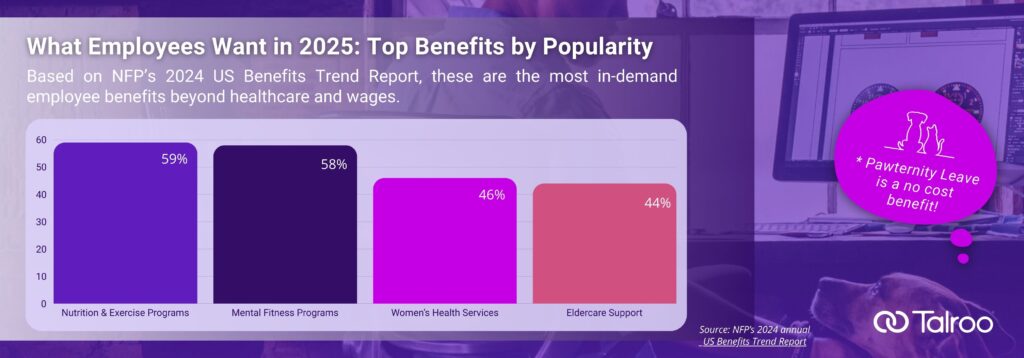
In today’s competitive job market, offering standard benefits like healthcare coverage, paid time off, and competitive wages is no longer sufficient to attract and retain top talent. Employees are increasingly seeking benefits that enrich their personal lives, support their well-being, and foster professional growth. Companies that recognize and implement these enhanced benefits not only stand out as desirable employers but also cultivate a more engaged and loyal workforce.
Worthy and unique benefits also allow many organizations to level the playing field without participating in a wage-race against competitive employers. Study-after-study from organizations like the Journal of Behavioural and Applied Management, Top Employers Institute, and even Ford demonstrate that workers are willing to receive less wages for an organization that supports them with strong benefits. In fact, Ford’s 2024 study found that nearly 60% of Gen Z employees would be willing to take a 20% pay cut for benefits that prioritize their quality of life.
According to benefits consultancy firm NFP’s 2024 annual US Benefits Trend Report, interest in additional programs and services is high: 59% of workers are looking for nutrition and exercise programs, 58% want mental fitness programs (meditation, resiliency and stress management), 46% are interested in women’s health services and 44% are interested in caregiving for elderly or ill family members.

Better benefits doesn’t have to automatically translate to more financial investment from your organization either, there are many benefits which are low or no “cost” that are still seen as extremely valuable from employees. Let’s review a wide range of both traditional and non-traditional benefits that can help organizations support their team and compete for the top employees.
1. Comprehensive Family Support
Employees value benefits that support their families in various stages of life. Providing comprehensive family-oriented benefits demonstrates a company’s commitment to its employees’ personal lives.
- Parental Leave and Childcare Support: Offering extended parental leave and childcare assistance can significantly impact employee satisfaction. For instance, Netflix provides new parents with up to a year of paid parental leave, allowing them to return to work at their own pace.
- Elder Care Assistance: As the workforce ages, employees may find themselves caring for elderly family members. Of the estimated 48 million people in the U.S. who are taking care of adult relatives or friends, a majority (61%) have been employed while caregiving, most of them full time, according to a 2020 report from AARP and the National Alliance for Caregiving.
2. Mental Health and Wellness Programs
Mental health is a critical component of overall well-being. One of the key factors in mental health for today’s workforce is the prevalence of burnout. According to data from The Society for Human Resources Management (SHRM), workers who are burned out from their work are nearly three times more likely to be actively searching for another job (45% versus 16% of those who did not report burnout). Employers that prioritize mental health create a supportive environment conducive to productivity and employee satisfaction.
- On-Site Counseling and Therapy Sessions: Providing access to mental health professionals within the workplace can encourage employees to seek help when needed. This proactive approach reduces stigma and promotes a culture of openness.
- Stress Management Workshops: Offering workshops focused on stress reduction techniques, such as mindfulness and meditation, equips employees with tools to manage work-related pressures effectively.
3. Professional Development Opportunities
Employees are keen to grow their skills and advance their careers. Companies that invest in their employees’ professional development foster loyalty and drive innovation.
- Tuition Reimbursement and Continuous Learning: Encouraging employees to pursue further education by reimbursing tuition fees not only enhances their skill sets but also brings new knowledge into the organization. Help Scout’s employees are offered an annual Learn Something stipend after they’ve been with the company for six months, which provides $1,800 a year to be used for any career-related learning and development opportunity.
4. Flexible Work Arrangements
Flexibility in how and where work is performed can greatly enhance employee satisfaction and work-life balance.
- Remote Work Options and Stipends: Allowing employees to work remotely and providing stipends for home office setups demonstrates trust and supports productivity.
- Flexible Scheduling: Empowering employees to adjust their work hours to accommodate personal commitments leads to increased morale and reduces burnout. Working parents, students, and (really) anyone who successfully worked from home during the pandemic have different expectations today than 10 years ago. We know flexibility works; companies just have to dive in.
5. Unique Perks and Incentives
Offering distinctive benefits can set a company apart and make it more attractive to potential hires.
- Pet-Friendly Workplaces and Pet Insurance: Allowing pets in the workplace or offering pet insurance acknowledges the importance of pets in employees’ lives. Some companies have introduced “pawternity” leave, or pet PTO (paid time off) for employees who acquire new pets, recognizing the need for time to settle in with a new companion.
- Sabbatical Programs: Providing extended time off after a certain period of service allows employees to recharge and return with renewed enthusiasm. One great example: Greenhouse Software offers eligible employees four weeks of paid sabbatical leave after seven years of employment. You’ve likely used Greenhouse’s ATS, but the company is also well-known for its unique and generous benefits (including a lifestyle spending account, wellness stipend…).
6. Integrating Benefits into Job Descriptions
Effectively communicating these benefits in job descriptions is crucial for attracting top talent. A well-crafted job description that highlights unique benefits can differentiate a company from its competitors.
- Comprehensive Benefits Summary: Toward the end of the job description, provide a concise summary of all the benefits offered by your organization. This could include healthcare plans, retirement savings options, paid time off, employee discounts, and other unique perks.
- Highlight Unique Perks: Emphasize any unique benefits that set your company apart, such as on-site childcare, pet-friendly policies, or professional development opportunities. This not only attracts candidates but also provides a glimpse into the company culture. In other words, if you offer pawternity leave to new pet parents or a generous coworking stipend for remote employees, make sure it’s on your career site.
- Use Clear and Engaging Language: Present benefits in a way that resonates with potential applicants. For example, instead of simply stating “flexible work options,” elaborate with “enjoy the freedom to work remotely or adjust your schedule to fit your lifestyle.”
Beyond ‘Basic’ is Going to Bring in Better Candidates
Incorporating meaningful benefits beyond the standard offerings is essential in attracting and retaining the best employees. By understanding and addressing the diverse needs of the modern workforce, companies can create a supportive and enriching environment that not only draws top talent but also fosters long-term loyalty and engagement. Clearly articulating these benefits in job descriptions ensures that potential hires are aware of the unique advantages your company offers, setting the stage for a mutually rewarding employment relationship.




